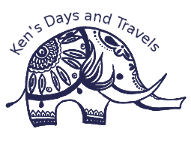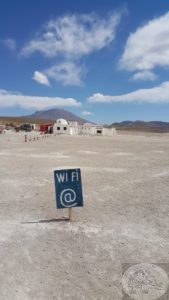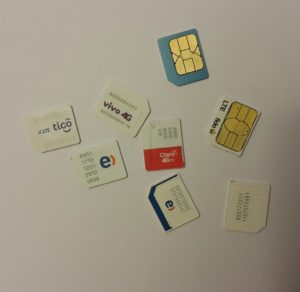A SIM, a SIM! My trip for a sim!
Well, although not quite as theatrical or literary as the cry from Richard III in Shakespeare’s play by that name, my trip would have been quite different if I had not had access to sim or chip cards for my telephone. Modern telecommunication has changed the face of travel dramatically. No longer do you buy a plane ticket, arrange a hotel or a rental car through a travel agent and hope that everything will be well when you get to your destination. You still do the hoping bit, but with the internet, most of us will now go online to search for the cheapest tickets, decide our hotel choices on location as well as customer reviews and pictures, and select other modes of transport after careful research. Sometimes we forget how much modern technology influences our travel choices and modes. We are made instantly aware of changes in safety and security in countries; government travel advisories are posted regularly, and it’s quite easy to locate the latest information on health and weather conditions. This opening paragraph has a couple of purposes, as I want to cover a couple of things related to the changing patterns of travel.
Apps for everything, and more…
As I wrote earlier, I did a lot of research online to sort out my transportation in South America – there are several decent apps out there that can provide you with a fairly accurate list of plane and bus schedules, including average prices for the various modes of transport. Having an app like that on your phone is definitely worthwhile. At the same time, I already mentioned how much of an expert I am with translation programs, so much so that I even had to teach a Venezuelan National Guardsman how to use it so he could interrogate me. What is obviously also important are apps or websites that provide accommodation information, and these range from hotels to motels and hostels to private homes and rooms for rent to places to stay for free. I used these apps extensively while I travelled, and on several occasions they really saved me a lot of hassle and a pretty good chunk of money too. The other thing that internet access has done for us is to make a huge amount of information available to us, and this is where you can start saving sums of money.
Spend some time, save some money
When I started mapping out my South America trip, I looked at Peru, and I recalled that the very first time I had visited that country nearly 16 years ago, I had been stopped at the airport on my way out of the country by the country’s Health Services Department. They asked to see my Yellow Fever vaccination certificate. I had brought my vaccination records booklet with me, but the 10-year period of coverage had expired, and so I should have gotten a booster shot before I travelled to South America. I hadn’t done so, and it was becoming an issue. I was not allowed to travel out of the country. But I had to leave. In that case, I had to get another shot, administered by the authorities in Peru, at the airport. Fine. I got the shot and was warned to seek medical help if I became sick over the next few days. Fortunately, I didn’t. This incident came back to me, and while still in Canada, I started researching where I could get a new vaccination for Yellow Fever. The nearest clinic was an hour’s drive away, and was a specific ‘travel’ clinic, no longer part of a hospital setting, and no, vaccinations at travel clinics are not covered by the Canadian medical insurance coverage. I called the clinic and was told that first I would have to make an appointment for a consultation, which would cost 150 dollars, and after that consultation, I would need to fork over an additional 450 dollars for the Yellow Fever vaccine. (I recalled that I had paid about 10 dollars for that exact same vaccine in Peru all those years ago). Six Hundred dollars, for a jab. I wasn’t so sure about that, so I turned to the internet and researched Yellow Fever and recommendations for vaccination as well as pricing. Turns out, there is now no requirement for yellow fever vaccination in most countries around the world, and there is also enough evidence in existence that shows that a vaccination may be good for up to 15 years, possibly even a lifetime. By spending an hour online, I had just saved myself 600 dollars, a wasted day, and a sore arm.
A movement-by-movement account of my progress
The other very important dimension of mobile telecommunications is the possibility to stay in touch, update, inform and in general, make things a heck of a lot easier. In a previous blog post I mentioned my messaging to my host in Cucuta and my progress along the highway to that city. In a similar manner my progress was tracked from Cucuta to Barquisimeto. Although I didn’t have a Venezuelan SIM or CHIP card, an entire group of people banded together to ensure constant (or near constant) progress reports of my trip. My host in Cucuta received a message from my angels in San Cristobal that I was on the bus and that the bus had departed the terminal. My host in Barquisimeto was similarly informed of my departure from San Cristobal. When we stopped for a midnight meal along the way, the WiFi service, although scant, allowed me to send a couple of messages off to the entire crew to let them know where I was, how things were progressing, and my updated estimated time of arrival at my destination. And just in case all that hadn’t worked out for me, my angel from San Cristobal had appointed another woman also travelling on the same bus, a total stranger with a cell phone, to send out similar messages at set points along the way. Ah the wonders of modern communications. I made it a point of acquiring a SIM or CHIP card as soon as possible in every country I travelled (only Venezuela was difficult, requiring plenty of documentation that I could not produce, so my friend had to buy a new number which I then used and had to destroy when I left the country). The cost of such a card, with sufficient internet time or data on the card is quite low, and extremely useful.
5,000 years ago people walked around with only a piece of hide wrapped around their loins, using blowpipes to hunt down prey. It all is very ‘traditional’ and ‘cultural’, but there are better tools out there now.
I know, there are travel purists out there who will scream that modern communications technology has destroyed the adventure of travel, the essence of ‘exploring’, of ‘discovery’, of truly measuring who you are as you grind your way through country after country, connected only with postcards, letter drops and telegrams. But that is like saying “well, 5,000 years ago people walked around with only a piece of hide wrapped around their loins, using blowpipes to hunt down prey”. It all is very ‘traditional’ and ‘cultural’, but there are better tools out there now, and if used properly, they can enhance the travel experience without destroying the element of discovery or exploration.



